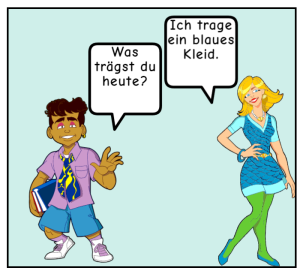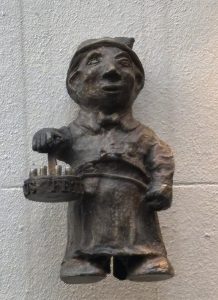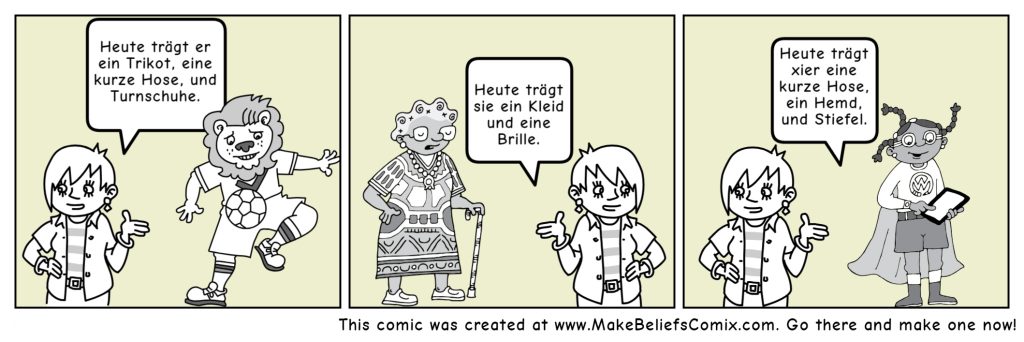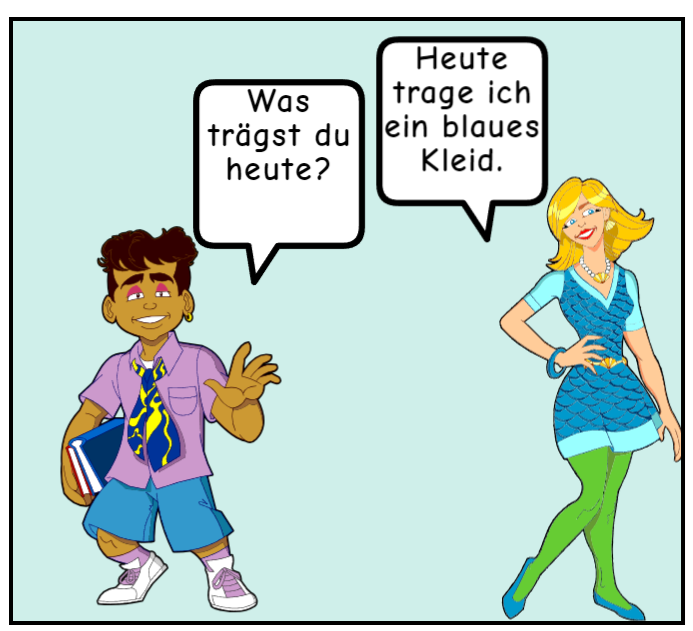3.9 Kleidung tragen

Hallo alle zusammen!
Zum Aufwärmen machen wir unseren Tagesminiplausch und eine Wiederholung.
Wiederholung
In the previous lesson you learned how to describe family members, note similarities, and describe people in art. Let’s review.
Jetzt bist du dran!
Do you look like someone in your family? Or, maybe you share a resemblance with your friend. In your written journal write a sentence noting a similarity between you and this person. Then practice saying it aloud and record the sentence once you feel confident.
Lektionsüberblick
Whether you consider yourself a fashionista or don’t give much thought to what you wear, at some point you will need to talk about your clothes or the clothing of others. By the end of this lesson, you will be able to 1) ask what someone is wearing, 2) name some items of clothing, 3) say what items of clothing you are wearing today, and 4) say what items of clothing another person is wearing today.
Was weißt du schon?
Check your existing skill level with the questions below.
| Noch nicht start klar?
Du kannst immer auf die gleiche 1010-Lektion zurückgreifen! |
Not confident about starting this lesson?
You can always review the same Lektion from 1010. |
1) Was trägst du heute?
Read and listen to the comic. Then answer the questions below.
 |
2) Mehr Kleidungsstücke
Let’s review and build vocabulary with the following activity.
Kleiner Hinweis
| Regen + Jacke = die Regenjacke (rain jacket) |
| Haus + Schuhe = die Hausschuhe (house shoes) |
| Hand + Schuhe = die Handschuhe (gloves) |
| Schnee + Stiefel = die Schneestiefel (snow boots) |
| Training + Hose = die Traininghose (athletic shorts) |
Now listen as the speaker describes what Kleidungsstücke she has in her closet. What Kleidungsstücke can you understand?
You can take a look at ThoughtCo’s page on fashion to learn more words and phrases.
Jetzt bist du dran!
Köln im Blickpunkt


Kölsch ist ein besonderes Bier aus Köln. Es wird durch EU-Recht geschützt: Nur Brauereien in und um Köln dürfen ihr Bier offiziell Kölsch nennen. Es ist hell, goldfarben und leicht fruchtig. Es wird in kleinen Gläsern, Stangen genannt, serviert. Die Köbes (Kellner*innen in der Region um Köln) bringen solange neue Stangen in einem Kranz, bis man sein Glas mit dem Untersetzer abdeckt.
Kölsch is a special beer from Cologne, Germany. It is protected by EU law: only breweries in and around Cologne can officially call their beer Kölsch. It is light, golden, and slightly fruity. It is served in small glasses called Stange. The waiters (called Köbes in the Cologne region) keep bringing new glasses in a wreath-shaped carrier until you cover your glass with a coaster.
3) Heute trage ich…
| Read the comic and Kleinen Hinweis.
|
Kleiner Hinweis Do you remember that you can say both “Es geht mir gut” and “Mir geht es gut“?
German is pretty cool. You can start a sentence with almost any part of a sentence and then just follow it up with the verb and the subject!
That means that you can also say “Ich trage einen Pullover heute” und “Heute trage ich einen Pullover“.
Starting a sentence with anything other than the subject emphasizes that thing. And the best part? No need to add a comma!
|
Let’s practice this word order.
Jetzt bist du dran!
4) Heute trägt er/sie/xier…
Read the comic below and then answer the questions that follow.

Jetzt bist du dran!
Zum Schluß

*As you conclude this lesson, don’t forget to check Canvas!*

Media Attributions
- “Kleidung” comic made at www.MakeBeliefsComix.com
- Photo of Früh Kölsch by Maik Fuhrmann, CC BY SA 3.0 © Maik Fuhrmann is licensed under a CC BY-SA (Attribution ShareAlike) license
- Kölner Köbes mit Kölsch © Rebecca Steele is licensed under a Public Domain license
- 3.9 comic make-beliefs-comix-19-2048×684 © This comic strip was generated at http://www.MakeBeliefsComix.com. Used by permission of author and site creator Bill Zimmerman.


